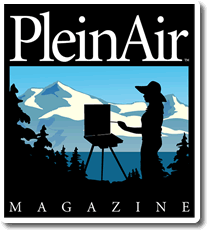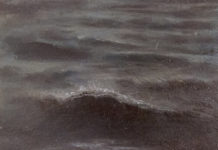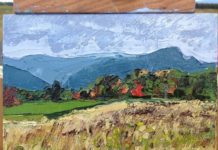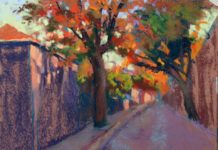If you entered the September/October PleinAir magazine Salon competition (www.pleinairsalon.com), you’ll have the good fortune of having your artwork reviewed by Michael Zakian, director of the Frederick R. Weisman Museum of Art at Pepperdine University. Read about this museum director who organizes exhibitions of plein air paintings.
As one of the judges of the PleinAir Salon competition, Michael Zakian brings his unique experiences as a museum director, artist, and writer. In the article that will be included in the January 2013 issue of PleinAir, he makes a number of helpful observations, including his belief that “the best painters have the capacity to reinvent and reinvigorate the plein air tradition.”
Q: You direct a museum that champions both representational plein air painting and Modernist abstractions. Is that because the museum is part of an educational institution that offers a broad range of experiences to its students, or because you personally believe there is more commonality between the various styles and forms of expression than is generally acknowledged?
MZ: The Weisman Museum of Art at Pepperdine University focuses on both modern art and traditional representational art. This dual concentration allows me to serve a broad array of interests both on campus and within the greater community. I guess that this perspective derives in large part from my own personal interests. Many people today look upon abstraction and realism as opposing enemy camps. I never understood this narrow thinking. I have always believed in the aesthetic quality of great visual art. Although it may seem common sense, this view is becoming increasingly embattled in today’s fragmented and divisive, postmodern art world. To me art should be measured by not its surface style, but by the depth of aesthetic experience it offers. I personally measure the success of any work of art by asking two simple yet fundamental questions: (1) does the visual image entice and engage my eye? and (2) what does that image tell us about our world? If I were to list my favorite artists, it would include the 18th-century Rococo painter Antoine Watteau and the American Abstract Expressionist Willem de Kooning. While they may seem worlds apart, both were involved in making powerfully engaging paintings that are rich and opulent but at the same time pensive and somewhat sad.
Q: In presenting the various exhibitions of plein air paintings of Malibu, can you suggest what you think are the strengths and weaknesses in contemporary painting from nature? Is there any advice you would give readers for elevating the quality of their work? Would you suggest that readers broaden their scope when they look for inspiration and information about the creative process?
MZ: Soon after I began work at the Weisman Museum, I organized an exhibition, Historic Landscapes of Malibu, in 1998 that featured vintage plein air paintings of the region from 1897 to the 1940s. I then turned to our contemporary plein air painters and began a long-standing relationship with the California Art Club. We did our first On Location in Malibu: Paintings by the California Art Club in 1999. Since then, we have organized four versions of the theme, occurring every three years.
What I enjoy about our Malibu plein air exhibitions is the variety of the artists’ vision. Although each exhibition involves essentially the same group of artists depicting the same part of California’s coastline, each show is dramatically different from the others. I find it encouraging to see that the best painters have the capacity to reinvent and reinvigorate the plein air tradition. The plein air paintings that seem weakest are those that lack this creative spark. The poorer examples tend to rely on pictorial cliches that make the finished paintings look tired and uninteresting. Artists should remember that plein air as a style is almost 140 years old. If you want to create strong, dynamic paintings, keep it fresh. Be bold. Be exciting. Look for new compositional ideas and don’t be satisfied with repeating old formulas. If artists are looking for ways to inspire their creative process, I would recommend studying great art of the past as much as you can. Today so much is available on the Internet. Also consider searching beyond the boundaries of your own art form. Read poetry or go to a dance recital. Often the impressions contained there about sensation and feeling, mood and atmosphere can impact your work in surprising ways.
Michael Zakian has been director of the Frederick R. Weisman Museum of Art at Pepperdine University since 1995. This art historian, curator, and critic has lectured and written extensively on modern and American art. A native of New York City, he received a B.A. in art history from Columbia University. He pursued graduate studies at Rutgers — The State University of New Jersey, which awarded him an M.A. and a Ph.D., both focused on American Abstract Expressionism. He is the former curator of the Palm Springs Desert Museum and the author of numerous books including Agnes Pelton: Poet of Nature, Sam Francis: Elements & Archetypes, Wayne Thiebaud: Works 1955 to 2003, and Russell Forester: Unauthorized Autobiography. He has taught at Rutgers University, the University of Redlands, and California State University, San Bernardino.




